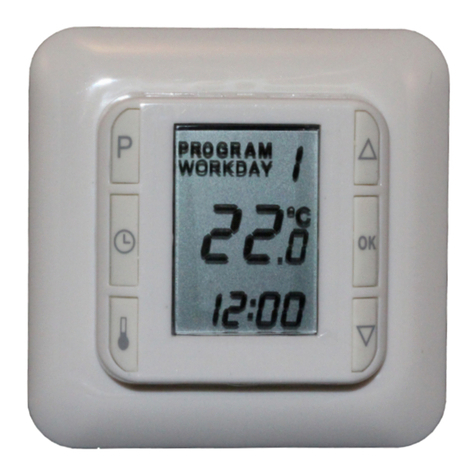
11) Resetting HC10B
This procedure will return HC10B to Quickstart. Any changed values in night and day setback will be lost.
Press and hold first [] then [▼] then [ P ] and finally [▲] –hold all 4 buttons for 4 seconds.
The display will go out and then everything will turn on again.
HC10B has now been reset and will be in Quickstart / manual mode.
12) Floor sensor status
Press []
FL: - -, sensor not connected, disconnected or short-circuited
FL: HI, other errors
13) Calibrating Room sensor.
This procedure will enable Room sensor to be calibrated by +/- 0 to 5 degrees C.
Suggestion: Before calibration, first set the thermostat to room sensor (see point 2.2). Then set the display to read out the
actual room temperature (see point 8)
After the calibration has been made the temperature can be switched back to desired temperature displayed (see point 8).
After calibration –wait half an hour and then check the temperature. After half an hour, the temperature is stable and the
temperature generated by the display light will no longer influence the room sensor.
Please note that the room temperature is influenced by many factors and will be less accurate than the floor sensor (see point
F.2).
Press [P] and hold. Then press also [] and hold both down for 16 sec.
Offset temperature will flash.
Use [▼] or [▲] to set the room temperature sensor offset +/- 0 to 5 degrees C.
Confirm by pressing [OK]. After approx. 45 s. the calibration will be active.
Installation
F) Positioning, installation and connection
F.1) Position and connection of floor sensor
Position of floor sensor in the room.
Position the floor sensor about 0.5 m from the wall.
Position the floor sensor near the HC10B. This gives the simplest installation.
If desired, the floor sensor cable can be extended.
Optional extension of floor sensor cable
Use ordinary doorbell cable to extend the floor sensor cable. Maximum extension 9m.
Position of floor sensor in floor.
Position the floor sensor in a pipe approximately half-way between two heating cables.
If necessary, the sensor may be placed in a grouting gap, without the use of I pipe.
Note: When positioning in a grouting gap, any regrouting should be undertaken with care in order not to damage the sensor.
Connection of floor sensor.
Connect the floor sensor to the HC10B as shown on the diagram.
F.2) Position and mounting of HC10B
Important! HC10B must not be covered.
If the floor sensor (FL) is used, any position may be used.
If the room sensor (RO) or combined room and floor sensor (CO) are used, HC10B must be positioned approximately 1.2
m above the floor.
Avoid:
Heat from radiators, wood-burning stoves and other heaters
Cold outer walls
Concealed pipes or chimneys which give off heat
Direct sunlight or positioning behind curtains
Installation can be carried out in two different ways:
Flush-mounted in the wall
Surface-mounted on the wall
Selection of installation box for flush mounting
For walls of wood, plasterboard etc, use flush-mounting box (53000003)
For walls of brick, concrete etc., use flush-mounting box (53000002)
Selection of installation box for surface mounting
When mounting on the surface of a wall, use surface-mounting box (53000001).
























